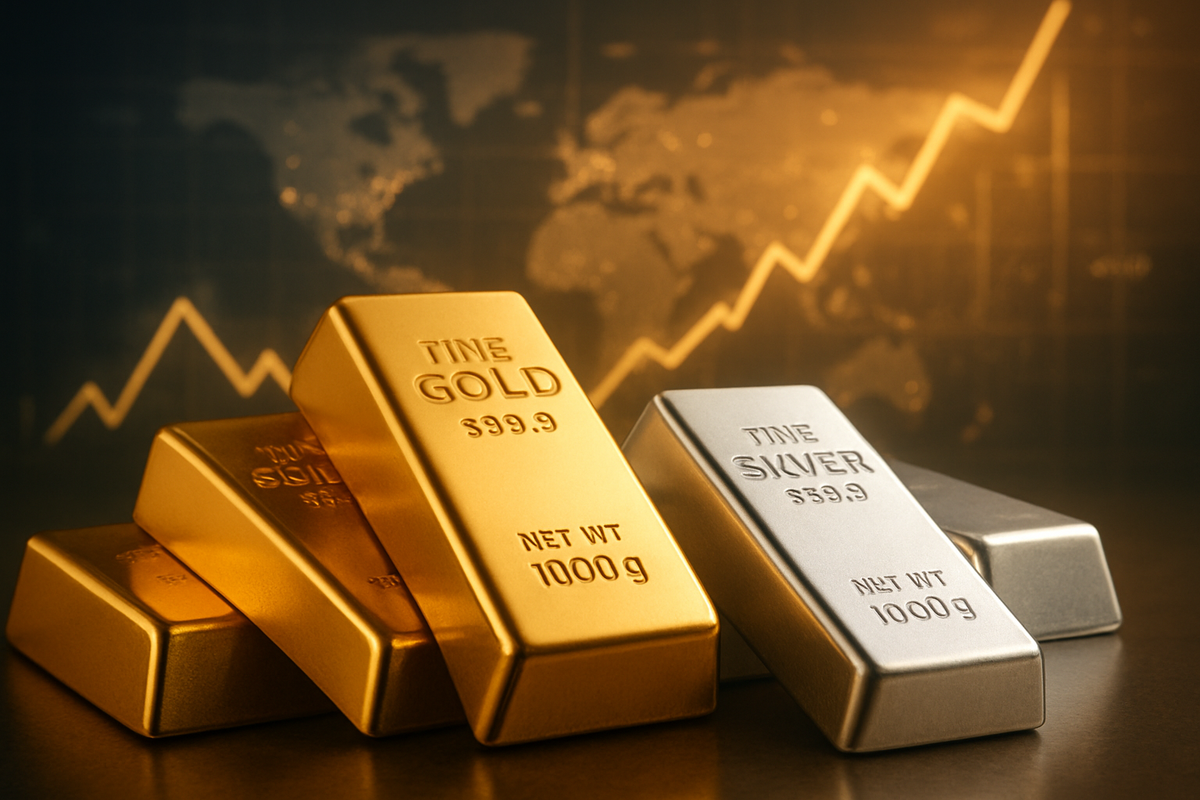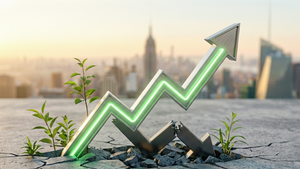
The financial markets are witnessing an extraordinary phenomenon in 2025, as gold prices have not only breached but comfortably surpassed the $4,400 per ounce threshold, settling around the $4,000-$4,076 range after briefly touching an all-time high of $4,381.58 on October 20, 2025. This historic rally, representing an astonishing 50-55% year-to-date surge, is mirrored by a significant and equally dramatic surge in silver, which recently peaked near $54-$55 per ounce before consolidating around $48-$52. This unprecedented ascent in precious metals signals a profound recalibration of global financial dynamics, driven by a confluence of macroeconomic anxieties, geopolitical fragmentation, and evolving investor sentiment, fundamentally reshaping investment strategies and industry outlooks.
The immediate implications of this surge are far-reaching. Gold and silver are reasserting their traditional roles as paramount hedges against inflation and safe havens amidst escalating global uncertainties. Financial analysts and investors, while acknowledging recent profit-taking corrections as "healthy consolidation," maintain a broadly bullish, albeit cautious, sentiment. The market is grappling with heightened volatility, yet the underlying drivers suggest a structural shift rather than a temporary anomaly, forcing a re-evaluation of asset allocation in portfolios worldwide.
Unpacking the Precious Metal Phenomenon: Drivers and Market Reactions
The meteoric rise of gold and silver in 2025 is the culmination of several potent forces converging simultaneously. Persistent global inflation, with the U.S. Consumer Price Index (CPI) remaining elevated at approximately 3.4% year-over-year as of June 2025, has eroded the purchasing power of fiat currencies, pushing investors towards tangible assets. Geopolitical instability, marked by ongoing conflicts in Ukraine and the Middle East, coupled with escalating trade tensions and political transitions, has significantly amplified demand for safe-haven investments.
A pivotal factor has been the shift in central bank policies. The Federal Reserve's aggressive monetary easing, characterized by a series of interest rate reductions that brought the benchmark rate into the 3.75%-4.00% range by late October 2025, has lowered the opportunity cost of holding non-yielding precious metals. Concurrently, central banks, particularly in emerging markets, have engaged in record-breaking gold accumulation, purchasing over 1,000 tonnes annually for four consecutive years. This strategic de-dollarization, aiming to reduce exposure to the U.S. dollar and mitigate confiscation risks, has seen gold's share of official global reserves climb to over 23%.
Silver's exceptional rally is further bolstered by tightening physical supply, critically low inventories, and insatiable industrial demand. The booming solar photovoltaic (PV) industry, a major consumer of silver, along with other green technologies, has driven industrial fabrication to new highs, contributing to a projected fifth consecutive year of market shortfall in 2025. Initial market reactions have included heightened volatility, sharp but often temporary corrections (gold tumbling 6-7% and silver plunging 10-12% from peaks), a significant boost for precious metal miners, and mounting cost pressures for industries reliant on silver.
Winners and Losers: Corporate Impacts of Soaring Prices
The unprecedented surge in gold and silver prices has created a clear divide in corporate fortunes, significantly benefiting mining companies while imposing substantial cost pressures on industries that rely on these precious metals as raw materials.
Major gold mining companies are experiencing a significant uplift in revenues and expanded profit margins. Global giants like Barrick Gold Corp. (NYSE: GOLD) and Newmont Corporation (NYSE: NEM) are poised for substantial benefits from gold prices sustained above $4,400 per ounce. Intermediate producers such as IAMGOLD Corporation (NYSE: IAG) (TSX: IMG) and Mexico's largest gold producer, Torex Gold Resources Inc. (TSX: TXG) (OTCQX: TORXF), are also seeing enhanced profitability and robust cash flows.
Silver miners, in particular, are enjoying an even more pronounced boost due to silver's dual role as a monetary and industrial metal. Pure-play silver miners like First Majestic Silver Corp. (NYSE: AG) have reported record production, directly translating to higher earnings. Other significant beneficiaries include Pan American Silver Corp. (NASDAQ: PAAS), Wheaton Precious Metals Corp. (NYSE: WPM) (a precious metals streaming company), Hecla Mining Company (NYSE: HL) (the largest primary silver producer in the U.S. and Canada), and Endeavour Silver (NYSE: EXK). These companies are seeing their valuations soar as the underlying commodity prices provide a powerful tailwind.
Conversely, industries heavily reliant on silver face considerable headwinds. The solar panel manufacturing industry is particularly vulnerable, as silver paste is a critical component in photovoltaic cells. Silver now accounts for an estimated 14% of solar module production costs, a significant jump from 5% in 2023. Major solar manufacturers like JinkoSolar Holding Co., Ltd. (NYSE: JKS) and Tata Power Solar Systems Ltd. (NSE: TATAPOWER) are grappling with escalating material costs that could impact their competitiveness and profitability. Similarly, the electronics manufacturing industry, which consumes approximately 35% of industrial silver demand annually for components in smartphones, computers, and semiconductors, is facing increased production costs. While specific tickers for individual electronics "losers" are not explicitly named, the entire supply chain, including semiconductor manufacturers and consumer electronics companies, is feeling the pinch.
Wider Significance: A Paradigm Shift in Global Finance
The sustained rally in gold and silver prices beyond historical precedents signifies a paradigm shift in global finance, reflecting deeper structural changes in the global economic and geopolitical landscape. This event is intrinsically linked to the accelerating de-dollarization movement, where nations, particularly in Asia and the BRICS economies, are actively reducing their reliance on the U.S. dollar. This strategic pivot, driven by concerns over currency volatility and geopolitical risks, has led central banks to accumulate gold at unprecedented rates, with gold's share of global reserves reportedly climbing towards 20% in Q1 2025, while the dollar's share has fallen below 47%. This consistent institutional demand provides a robust, long-term structural support for gold as an alternative monetary asset.
Furthermore, precious metals are serving as crucial inflation hedges amidst persistent global inflation, safeguarding purchasing power against the erosion of fiat currencies. Silver's surge, in particular, is inextricably tied to the global energy transition. Its indispensable use in rapidly expanding green technologies—solar photovoltaic panels (20-25 grams per panel) and electric vehicles (25-75 grams per vehicle)—has created an insatiable industrial demand, providing a strong price floor independent of monetary factors. The confluence of these factors suggests that precious metals are not merely reacting to cyclical economic shifts but are rather assuming a new geopolitical significance in a "multipolar world."
The ripple effects are profound. Central banks have become "voracious buyers" of gold, fundamentally altering gold's market dynamics and impacting the U.S. dollar's global standing. Investor sentiment has decisively shifted, with gold-backed Exchange Traded Funds (ETFs) seeing record inflows, pushing total assets under management to $472 billion in Q3 2025. This has led to a growing interest in real assets for portfolio diversification, challenging traditional investment models. While other commodities are generally projected to decline to a six-year low by 2026, gold's exceptional performance highlights its unique non-correlated asset status. Regulatory bodies like the Commodity Futures Trading Commission (CFTC) and the Securities and Exchange Commission (SEC) are likely to increase scrutiny amidst the heightened volatility and speculative positioning in commodity markets, while central bank monetary policy faces complex challenges in managing inflation alongside economic activity. Historically, this rally echoes the 1970s and 1980s, when inflation, deficit spending, and geopolitical instability fueled similar surges, but the current environment is unique due to the combined force of de-dollarization and green technology demand.
What Comes Next: Navigating the Precious Metals Landscape
Looking ahead, the precious metals market is poised for continued dynamism, with both short-term volatility and long-term structural tailwinds. In the immediate future, market movements will be highly sensitive to Federal Reserve policy. A dovish stance, potentially signaling further interest rate cuts due to sticky inflation or an economic slowdown, could trigger a swift rebound for gold. Conversely, a stronger U.S. economy or a more hawkish Fed could temporarily exert downward pressure. Silver, being more volatile, may see continued consolidation within its current range, influenced by industrial demand trends.
Long-term possibilities remain overwhelmingly bullish. Analyst forecasts for gold beyond 2025 include targets ranging from $4,000 by Q2 2026 to $5,000 by HSBC in 2026, and even $5,500-$6,000+ during this cycle, with some eyeing $8,000 by 2028. Silver is widely expected to outperform gold, with targets ranging from $85-$100 (conservative) to $125-$150 (moderate) and even $200+ per ounce in aggressive scenarios, driven by its critical role in the energy transition and ongoing supply deficits. Strategic pivots for investors include prioritizing diversification with precious metals, "buying the dips" during corrections, and recognizing silver's higher leverage. Industries, particularly those reliant on silver, must focus on securing supply chains and investing in R&D for material substitution.
Potential scenarios range from continued upward trends (most likely, driven by persistent inflation, geopolitical tensions, central bank buying, and industrial demand), to intermittent significant corrections (viewed as buying opportunities), and less likely, stabilization without new significant catalysts. The current environment strongly suggests a structural bull market for precious metals, with corrections serving as temporary pauses rather than reversals.
Wrap-Up: Enduring Impact and Investor Vigilance
The unprecedented surge in gold and silver prices in 2025 marks a pivotal moment in financial history, underscoring the enduring significance of precious metals in an increasingly complex and uncertain world. The key takeaways are clear: gold and silver are powerful hedges against inflation and geopolitical risk, central bank actions are fundamentally reshaping the demand landscape, and silver's critical role in the energy transition provides a unique and robust demand driver.
Moving forward, the market is expected to remain in a structural bull trend, characterized by strong underlying fundamentals. Investors should anticipate continued volatility, with pullbacks offering strategic entry points. The de-dollarization narrative, persistent inflation, and global geopolitical fragmentation are powerful forces that are unlikely to dissipate soon, ensuring precious metals retain their allure.
Investors should watch for shifts in central bank monetary policy, particularly interest rate decisions, and monitor global inflation data. Geopolitical developments, especially those impacting global trade and stability, will also be critical. Finally, observing the supply-demand dynamics in the industrial silver market will provide crucial insights into silver's trajectory. This era of elevated precious metal prices is not merely a fleeting moment but a profound indicator of a shifting global financial order, demanding vigilance and adaptability from all market participants.
This content is intended for informational purposes only and is not financial advice





